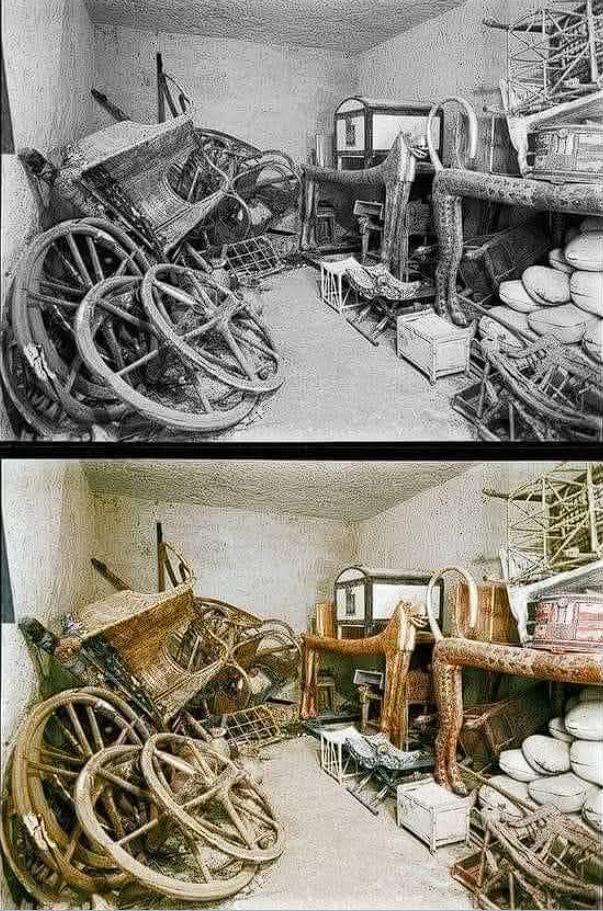Imagine this: 1922, Howard Carter, a British archaeologist, peers into a tomb sealed for over 3,000 years. What did he see? Just one word: “Wonderful things.” And boy, was he right! The discovery of Tutankhamun’s tomb in Egypt’s Valley of the Kings wasn’t just another find; it was a portal into a lost world, a snapshot of ancient Egyptian royalty and their profound beliefs about eternity.
A Time Capsule of Royal Splendor: “A Dazzling Snapshot”
- A Tomb Untouched: “5,398 Artifacts of Exquisite Craftsmanship”:
- When Carter breached that sealed door, he stepped into a burial chamber that had remained undisturbed for millennia. “It was like walking into a museum frozen in time,” recalls Dr. Evelyn Peters, an Egyptologist, describing the sheer volume and splendor of the artifacts. “5,398 objects, each telling a story, each a testament to the skill and artistry of ancient Egyptians.”
- This wasn’t just a collection of treasures; it was a carefully curated display, a final farewell to a boy king, packed with everything he might need in the afterlife.
- The Golden Coffin: “Cradling the Body of the Boy King”:
- At the heart of the tomb lay a solid gold coffin, a masterpiece of craftsmanship, cradling the mummified body of Tutankhamun. “Imagine the weight of history, the sheer opulence of that coffin,” says historian Mark Thompson. “It wasn’t just a burial; it was a royal statement, a declaration of divine status.”
- This wasn’t just a coffin; it was a symbol of power and immortality, a vessel designed to carry the pharaoh into eternity.
- Objects of Daily Life and Ritual: “Placed With Intention”:
- Surrounding the golden coffin were objects both grand and mundane: thrones, chariots, wine jars, sandals, even linen underwear. “Every item, from the ornate to the everyday, was placed with intention,” explains archaeologist Sarah Davies. “They weren’t just random objects; they were offerings, tools for the afterlife, a glimpse into the daily life of royalty.”
- This wasn’t just a burial; it was a meticulously planned journey into the afterlife, with every object serving a purpose.
Mysteries and Marvels: “From Earth and the Stars”
- A Decade of Documentation: “Unraveling the Clues”:
- It took Carter and his team a full decade to document and remove the treasures, each piece offering a clue into Tutankhamun’s reign and the society that venerated him. “It was a slow, painstaking process,” says Carter’s biographer, James Wilson. “But every artifact revealed a new piece of the puzzle, a new layer of understanding.”
- This wasn’t just excavation; it was a historical investigation, a careful unraveling of the past.
- The Meteoritic Dagger: “Forged in the Stars”:
- Among the more mysterious items was a dagger with a blade of meteoritic origin, its metal forged not on Earth, but in the stars. “This dagger wasn’t just a weapon; it was a cosmic artifact,” says metallurgist Dr. Emily Carter. “It suggests that ancient Egyptians had knowledge of metallurgy beyond our initial assumptions.”
- This wasn’t just a find; it was a revelation, prompting fresh scientific interest and challenging our understanding of ancient Egyptian technology.
- A Legacy of Fascination: “How Much They Can Still Teach Us”:
- Today, more than a century after its discovery, the tomb of Tutankhamun still captivates researchers and the public alike. “It’s not just the richness; it’s the mystery, the sense of connection to a civilization so distant,” says historian David Roberts. “It reveals just how far ancient civilizations went to prepare for eternity—and how much they can still teach us.”
- This wasn’t just a discovery; it was a legacy, a continuing source of wonder and inspiration.
Conclusion:
Tutankhamun’s tomb, with its “wonderful things,” remains a powerful testament to the grandeur and sophistication of ancient Egyptian civilization. It’s a reminder that history isn’t just about the past; it’s about the stories, the beliefs, and the artistry that continue to resonate with us today. And as we continue to explore its treasures, we’re not just uncovering artifacts; we’re uncovering ourselves.

CÁC TIN KHÁC
Mary Walton: The Forgotten Inventor Who Helped Clean Up America’s Cities
Tomb of Queen Nefertari in the Valley of the Queens, Egypt
Discover the Hypostyle Hall of the Temple of Hathor at Dendera
Venus de Losange: Unveiling the Mystery of a 20,000-Year-Old Paleolithic Icon